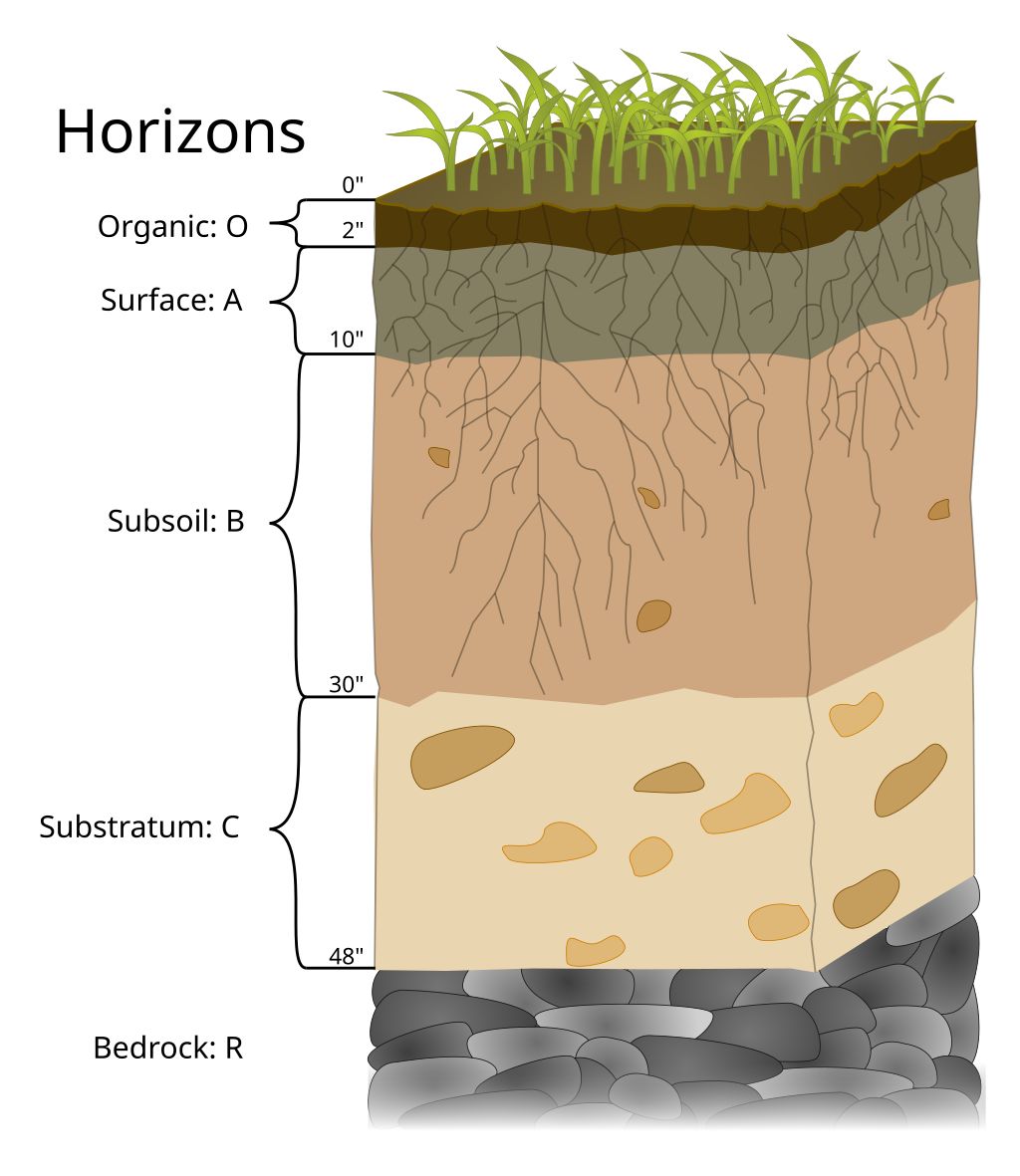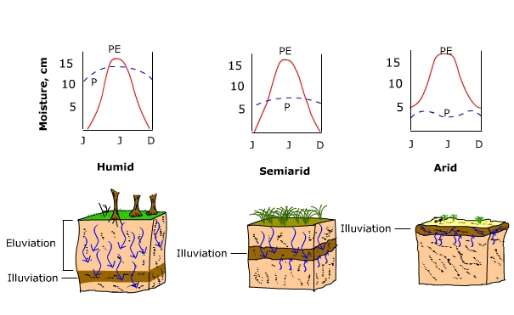IB Syllabus focus:
‘Soils develop layered profiles over long timescales, with organic-rich upper horizons transitioning to increasingly mineral layers below.’
Soils develop slowly over centuries, forming distinct horizons that reflect complex interactions between organic inputs, mineral breakdown, and environmental conditions, shaping their structure and fertility.
Soil Development and Profiles
Soil is not uniform; it forms profiles that reveal layers or horizons with different compositions. These horizons arise through long-term processes of weathering, decomposition, and translocation of materials.
Soil Profile: A vertical section of soil showing all of its horizons, from the surface layer to the unaltered parent material.
Soil development is influenced by several key factors, often summarised as CLORPT:
Climate: Temperature and precipitation control rates of weathering and organic matter decomposition.
Organisms: Plants, animals, fungi, and microorganisms contribute organic matter and influence mixing.
Relief: Slope and drainage affect erosion, leaching, and soil depth.
Parent material: The original rock or sediment determines mineral content and texture.
Time: Horizon formation is a slow process, often requiring centuries or millennia.
Major Soil Horizons
A typical soil profile contains several distinct horizons, each with unique properties.

Idealised soil profile showing the master horizons: organic-rich O, mineral A, subsoil B, and substratum C (with R as parent material beneath). This diagram supports recognition of layered profiles that develop over long timescales. Some soils may lack one or more horizons, which is consistent with natural variability. Source.
O Horizon (Organic Layer)
Composed mainly of leaf litter, decaying biomass, and organic residues.
Rich in humus, which improves soil fertility and structure.
Prominent in forests but thinner in grasslands and deserts.
A Horizon (Topsoil)
Mix of minerals and organic matter, forming the most biologically active layer.
Contains many roots and microorganisms that drive decomposition and nutrient cycling.
Critical for plant productivity due to high nutrient availability.
Topsoil: The upper layer of soil (A horizon), rich in organic material and essential nutrients, supporting most plant growth.
E Horizon (Eluviation Layer)
Zone of leaching where minerals like clay, iron, and aluminium are washed downward.
Appears pale or bleached due to loss of materials.
Not always present in all soils, but common in humid regions.
B Horizon (Subsoil)
Zone of accumulation (illuviation) where leached materials are deposited.
Rich in clays, oxides, and salts, giving it denser structure.
Often less fertile than topsoil but important for long-term nutrient storage.
C Horizon (Parent Material)
Weathered rock fragments and partially decomposed parent material.
Provides the base minerals for soil development.
Not significantly altered by biological processes.
R Horizon (Bedrock)
Unweathered rock beneath the soil profile.
Serves as the foundation but not part of the active soil system.
Soil Development Processes
Several processes shape the formation of soil horizons over time.
Additions
Organic matter from plant litter and dead organisms.
Dust and sediments deposited by wind and water.
Transformations
Decomposition of organic matter into humus.
Weathering of minerals into finer particles.
Chemical changes altering soil chemistry.
Transfers
Movement of clay, salts, and organic matter between horizons.
Processes like leaching, percolation, and capillary action redistribute nutrients and minerals.
Losses
Erosion removes topsoil.
Leaching carries soluble nutrients away.
Plant uptake extracts water and minerals.
Soil Horizon Development Over Time
Soil profiles evolve gradually, reflecting the balance between additions, transformations, transfers, and losses.

Diagram showing downward eluviation from upper horizons and illuviation into subsoil, contrasted for humid, semiarid, and arid settings. This clarifies how climatic water balance governs the position and intensity of E and B horizons. The figure includes climate context beyond the core syllabus but directly explains layered development. Source.
Young soils: Shallow, with poorly defined horizons.
Mature soils: Distinct O, A, B, and C horizons visible.
Old soils: Highly leached, sometimes nutrient-poor, with strong horizon differentiation.
Pedogenesis: The process of soil formation through physical, chemical, and biological processes acting on parent material over time.
The rate of pedogenesis varies:
In humid tropical regions, soils develop faster due to high weathering.
In arid climates, horizon development is slow, and soils may remain shallow.
Importance of Soil Profiles and Horizons
Understanding soil profiles is essential for environmental science because they reveal the history, fertility, and potential use of soils. Profiles indicate:
Nutrient availability for agriculture.
Drainage capacity, influencing crop choice.
Erosion risks, as thin or poorly developed soils are more vulnerable.
Carbon storage potential, since organic-rich horizons act as carbon sinks.
Human Impacts on Soil Profiles
Human activities alter natural soil development, sometimes accelerating degradation.
Deforestation removes organic inputs, thinning the O and A horizons.
Intensive agriculture can compact soils, reduce humus, and increase erosion.
Irrigation and fertilisers may change chemical balances, affecting horizon stability.
Soils that took centuries to develop can be degraded in decades through mismanagement, making understanding horizons critical for sustainable land use.
FAQ
Forests supply large amounts of organic litter that accumulate in the O horizon, which enhances humus formation. Acidic conditions under coniferous forests often promote the development of a pale E horizon due to strong leaching.
The presence of an E horizon depends on climate and drainage.
In humid areas with high rainfall, leaching is more intense, creating a distinct bleached horizon.
In drier or poorly drained soils, insufficient leaching prevents its formation.
On steep slopes, erosion removes material faster than horizons can form, leading to shallow profiles.
On flat or gentle slopes, slower runoff and better infiltration allow deeper development and clearer horizon differentiation.
Parent material determines the mineral base from which soils develop. Granite produces sandy horizons with quartz dominance, while basalt creates clay-rich horizons with iron oxides that impart red or brown colours.
With more time, soils undergo repeated cycles of weathering, leaching, and organic accumulation. This gradually thickens horizons and increases differentiation, producing mature profiles with clear O, A, B, and C layers. In young soils, horizons are thin and poorly developed.
Practice Questions
Question 1 (2 marks):
Identify two factors from CLORPT that influence the development of soil horizons.
Mark scheme:
1 mark for correctly naming each factor, up to 2 marks maximum.
Possible answers:Climate (temperature/precipitation) (1)
Organisms (plants, animals, microorganisms) (1)
Relief (slope/topography) (1)
Parent material (rock/sediment type) (1)
Time (duration of soil formation) (1)
Question 2 (5 marks):
Explain how the processes of eluviation and illuviation contribute to the development of soil horizons.
Mark scheme:
Explanation that eluviation involves the leaching/removal of minerals and organic matter from upper horizons such as the A/E horizon (1).
Clear identification of materials commonly leached (e.g. clay, iron, aluminium, organic matter) (1).
Explanation that illuviation involves deposition/accumulation of these leached materials in lower horizons, typically the B horizon (1).
Linking eluviation and illuviation as connected processes shaping layered horizon development (1).
Reference to climate or water movement as a factor driving eluviation/illuviation (e.g. humid regions enhancing leaching) (1).
Maximum: 5 marks.

